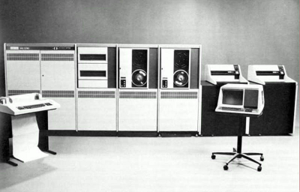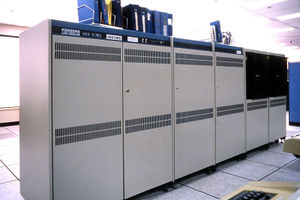VAX-11/780
| VAX-11/780 | |
| Summary | |
|---|---|
| Announcement date: | October 1977 |
| Codename: | Star |
| OS support (VMS): | VMS V1.0 |
| CPU Details | |
| CPU name (VMS): | KA780 |
| Number of processors: | 1 |
| CPU technology: | Bipolar Schottky |
| CPU cycle time: | 200ns [1] |
| Instruction-buffer: | 8 bytes [1] |
| Translation-buffer: | 128 entries [1] |
| Control store: | 4K 99-bit words [1] |
| Gate delay: | 3ns |
| User Writable Control Store: | 2K 99-bit words [1] |
| Cache: | 8KB [1] |
| Compatibility mode: | Yes [1] |
| Console processor: | LSI-11 [1] |
| Console device: | RX01 [1] |
| Memory | |
| Minimum memory: | 2MB |
| Maximum memory: | 64MB |
| Physical address lines: | 30 |
| Memory checking: | 8-bit ECC/longword [1] |
| I/O | |
| Max I/O throughput: | 5.0MB/s |
| MASSBUS: | 4 @ 2.0MB/s |
| UNIBUS: | 4 @ 1.5MB/s |
| LAN support: | optional |
| Performance | |
| VUPs: | 1.0 [2] |
The VAX-11/780 was the first member to ship of the VAX family of larger computers. The VAX series was conceived as the successor to the successful PDP-11 series of minicomputers; in order to make the VAX seem more PDP-11 friendly, they retained the -11 moniker for the first VAXen, and provided the ability to execute PDP-11 object code - hence the -11/780 designation.
One of the main design goals was to increase the address space available, in fact the 'VAX' acronym originally stood for Virtual Address eXtension).[3] The first VAX-11/780 systems shipped with one quarter of a megabyte of main memory, built from 4Kb chips.[3]
The 11/780 didn't have just firmware; instead, like the KL10, it loaded microcode from secondary storage (a floppy disk), under the control of a front end (a PDP-11/03).
It was announced on October 25th, 1977 at DEC's Annual Meeting of Shareholders.[4] The VAX-11/780 was given the codename "Star" and its operating system, VAX/VMS, was codenamed "Starlet".[4] VAX/VMS Version V1.0 shipped in 1978, along with the first revenue-ship 11/780s.
There was also the VAX-11/785, which was an upgraded version.
Contents
Subsystems
The CPU was the KA780 CPU. It could take an optional floating point accelerator, the FP780 Floating-Point Accelerator; the floating point instructions were performed by the microcode when it was not installed.
The CPU and the other major subsystems in the VAX-11/780:
- the MS780 Memory System main memory;
- I/O bus adapters:
were connected via a new bus, the Synchronous Backplane Interconnect (SBI). A multi-port memory, the MA780 Multiport Memory Option, allowed creation of multi-processor systems.
Dual-CPU experiment
"In 1981, [George H. Goble] wired together the backplanes of two DEC VAX-11/780's and made the first multi-CPU Unix computer, preceding DEC's dual processor VAX-11/782. The operating system was based on the 4.2 BSD kernel, and the modifications thus made eventually made it into the 4.3 BSD Unix release. At the beginning of the 4.3 BSD user manuals, Bill Joy wrote a special note of thanks to GHG for being courageous enough to put the multi-CPU kernel into a production environment before anyone else did. (However, the frequent crashes for a while inspired the writing of many humorous text files by the Purdue University Electrical Engineering student body, such as 'The VAX had a Blowout', to be sung to the tune of London Bridge is Falling Down). The development of the Dual-CPU Unix system was the subject of Goble's Master's thesis."
DEC eventually produced a productized version, the VAX-11/782.
Operating Systems
The 11/780 was to ship with VMS 1.0.
Emulation
SIMH is the only known emulator for the 11/780. SIMH can address up to 128MB of RAM emulating an 11/780. Also the following peripherals are emulated:
- CPU VAX-11/780 CPU
- TLB translation buffer
- SBI system bus controller
- MCTL0,MTCL1 memory controllers, MS780C with 4MB memory each, or MS780E with 8MB-64MB each
- UBA DW780 Unibus adapter
- MBA0,MBA1 RH780 Massbus adapters
- TODR time-of-day clock
- TMR interval timer
- TTI,TTO console terminal
- RX console RX01 floppy disk
- DZ DZ11 8-line terminal multiplexer (up to 4)
- CR CR11 card reader
- LPT LP11 line printer
- RP RP04/05/06/07, RM02/03/05/80 Massbus disks, up to eight drives
- HK RK611/RK06(7) cartridge disk controller with eight drives
- RL RL11/RL01(2) cartridge disk controller with four drives
- RQ UDA50 MSCP controller with four drives
- RQB second UDA50 MSCP controller with four drives
- RQC third UDA50 MSCP controller with four drives
- RQD fourth UDA50 MSCP controller with four drives
- RY RX211 floppy disk controller with two drives
- TS TS11 magnetic tape controller with one drive
- TQ TUK50 TMSCP magnetic tape controller with four drives
- TU TM03 tape formatter with eight TE16/TU45/TU77 drives
- XU DEUNA/DELUA Ethernet controller
- XUB second DEUNA/DELUA Ethernet controller
More information about SIMH's VAX 11/780 emulation can be found here.
Related documents
References
See also
- VAX-11/780 & VAX-11/782 Revision Control
- Installing VMS V1.0 on SIMH
- Customizing VMS V1.0
- Playing DUNGEON on VMS V1.0
External links
- 780 docs on BitSavers
- VAX-11/780 Installation Manual (EK-SI780-IN-002)
- VAX-11/780 Hardware User's Guide (EK-11780-UG-001)
- VAX Maintenance Handbook VAX-11/780 (EK-VAXV2-HB-002)
- 11780 Field Maintenance Print Set (MP00539)
- Joel S. Emer, Douglas W. Clark, A Characterization of Processor Performance in the VAX-11/780 - contains an excellent overview of the internal structure of the KA780
- Joel S. Emer, Douglas W. Clark, Retrospective: Characterization of Processor Performance in the VAX-11/780
- A Dual Processor VAX 11/780
| v • d • e VAX Computers and Operating Systems |
|---|
| VAX-11/7xx (including VAX 86x0) - VAX-11/780 • VAX-11/785 • VAX-11/750 • VAX-11/730 • VAX-11/725 • VAX 8600 • VAX 8650
VAX 8000 series (excluding VAX 86x0, above) - VAX 82xx/83xx series • VAX 85xx/87xx/88xx series MicroVAXen (many types also come in VAXserver and VAXstation models) - MicroVAX I • MicroVAX II VAXstation Series - VAXstation I • VAXstation II Late Model VAXen - VAX 4000 series • VAX 6000 series • VAX 7000 series • VAX 9000 series • VAX 10000 series |
| Special Purpose VAXen - VAXft series • rtVAX series • Infoserver series
Clones - CM 1700 • TPA-11/580 |

